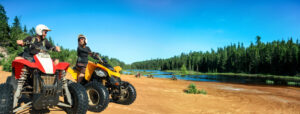In 2018, the Motorcycle Industry Council found that more than 8 percent of United States households owned at least one motorcycle, the largest number ever recorded. Powersports in general, meanwhile, saw an 18.4 percent jump in sales last year.
This is spectacular news for powersports retailers, but it might come as a surprise to the public at large. There’s a perception that younger consumers aren’t interested in powersports vehicles due to price or lifestyle preferences, but clearly there’s a market of millennial buyers to tap into – if you know how.
When attempting to attract new, younger customers, the natural inclination may be to use equally new marketing strategies. After all, you can’t market to today’s consumers as if it’s still the 1970s.
However, scrapping classic marketing strategies altogether can also mean overlooking what makes powersports so appealing in the first place, regardless of age, income, or location. Let’s look at some classic marketing approaches that, with a little polishing, can still be effective in attracting new generations of customers.
Appeal to Adventure
You know a motorcycle is far more than a pair of wheels and an engine. Motorcycles, and to a certain extent powersports vehicles in general, carry with them a sense of freedom and exploration.
Millennials might not necessarily buy into the rebellious, devil-may-care motorcycle culture that entranced baby boomers, but they crave adventure all the same. When you market powersports vehicles, you’re selling the idea of an escape from the mundane. In the case of today’s buyers, that means a break from screens, work, and social media.
Your younger customers will value the experiences they get from purchasing a powersports vehicle just as much, if not more, than the vehicle itself. The United States boasts hundreds of miles of ATV-friendly trails, parks, and dunes begging to be explored. ATVs also go hand-in-hand with camping, which continues to surge in popularity.
Just as baby boomers cruised down highways on motorcycles as a means of self-expression, millennials will do the same as a way to escape the mundane and chase valuable life experiences. It’s up to you to offer them the perfect getaway vehicle.
Lean into Lifestyle
When you successfully market a way of life, you garner loyal, long-term customers, and utility terrain vehicles are your best bet at doing so.
In a nationwide survey conducted by Powersports Business, the majority of retailers said their primary customers are 50+ year old men who own farmland. Clearly, retailers recognize UTVs are a perfect match for older individuals who need to transport heavy loads across multiple acres of terrain every day.
Why not apply this same logic to younger demographics? The same report also mentions customers as young as 20 buying UTVs for a variety of activities.
Tap into the wide world of outdoor recreationalists who could take their weekend hobbies to the next level with one of your UTVs. Camping, hunting, and fishing saw a leap in popularity during the pandemic as people craved outdoor activities and states made obtaining a license easier. Not only is it a great way to get away from the work grind, but hunting goes hand-in-hand with wildlife conservation and preservation efforts, which resonates with many environmentally-conscious millennials.
Every business wants lifelong customers, but first you have to offer them something they’ll use for the rest of their lives.
Consider the Costs
As long as motorcycles and cars have shared roads, motorcycle retailers have used price as a selling point. However, a generation of consumers hesitant to make large purchases are very aware of the additional expenditures that come with motorcycle ownership, be it gear, lessons, or regular maintenance.
However, if you think cost is no longer a valid pitch, think again. More accurately, think wider.
Educate your prospective customers on the fewer resources used in motorcycle production compared to automobiles, which require far more parts to assemble. Highlight how motorcycles put less wear on roads and take up far less space per passenger, considerably easing the burden on cities when it comes to maintaining streets.
Of course, you can also pitch customers on electric alternatives, be it a motorcycle, ATV, or UTV. Not only do these typically involve fewer parts and pollute far less than their gas-fueled counterparts, but they are often more affordable in terms of sale price, future upkeep, and fuel.
We’re supposed to learn from the past, not ignore it. The history of powersports marketing is a treasure trove of lessons your business can use today to tap into new demographics without alienating your most loyal customers.
